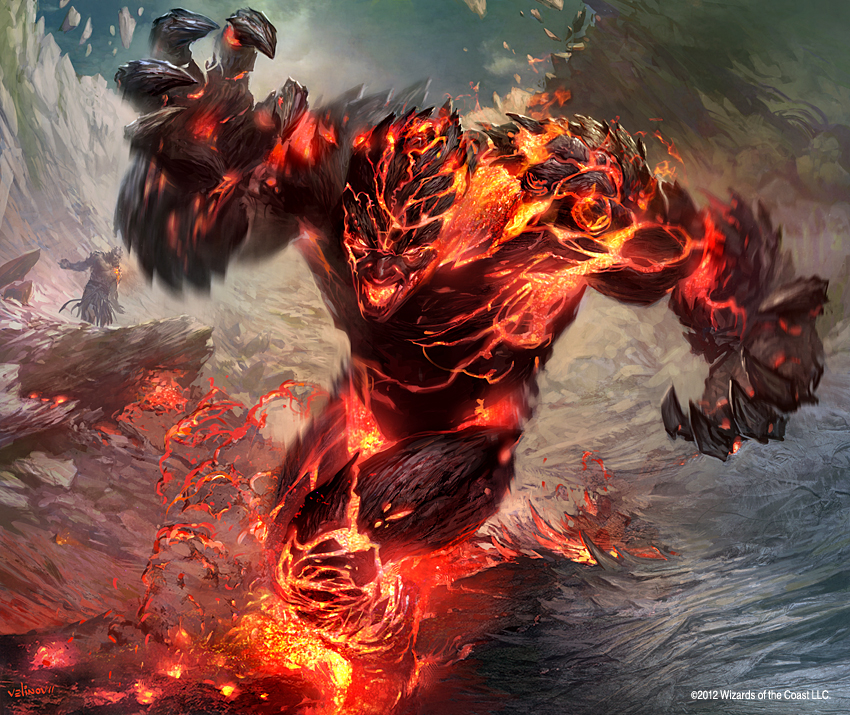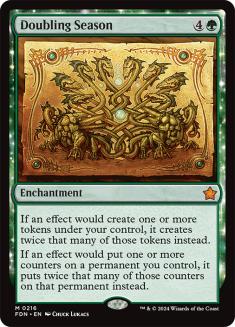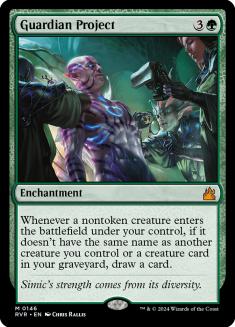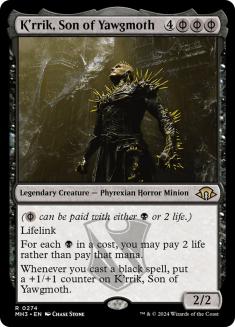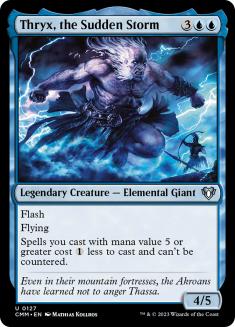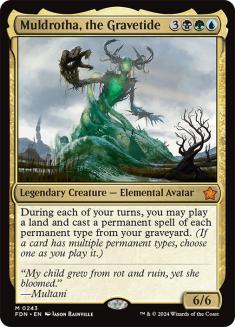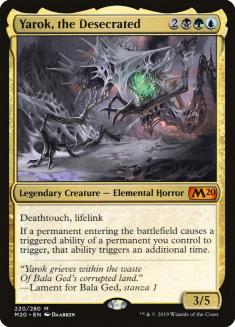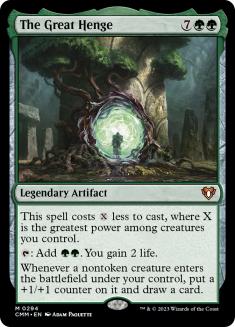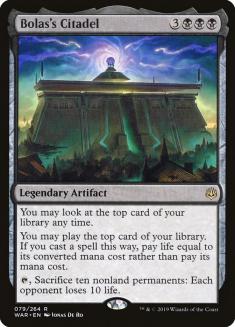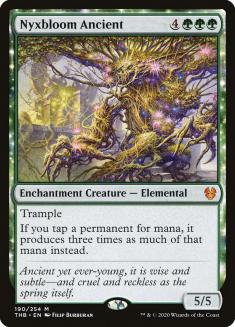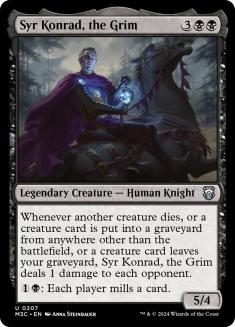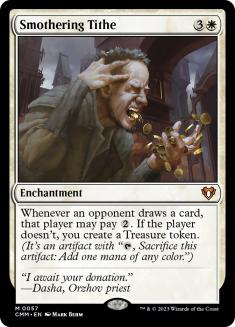There are some very powerful cards that see a great deal of play in Commander. If they’re not game-winners, they’re cards that dictate the pace of play and tilt the battlefield in their own direction. They’re cards that are so good that you simply can’t get angry when someone blows them up. As I’ve done multiple times over the course of the last decade or so, here’s a list of those cards. Instead of being a historical retrospective or greatest hits list, this one focuses on the cards which have been produced in the last two years or so.
By implication, blowing up something means it’s a permanent. There are any number of instants and sorceries that demand getting countered, like Nexus of Fate or Cyclonic Rift. The Can’t Get Angry List has historically focused on things which impact the game state on a continuing basis. They’re cards you put out there and want to use and are so good that it’s reasonable for other players to want to get rid of them. You can’t even get salty if you don’t get to use the card even a single time, although in the case of Can’t Get Angry List hall-of-famer Lurking Predators, you get at least one.
I also leaned on the members of the Commander Advisory Group (CAG), especially Charlotte Sable and Adam Styborski, for help in coming up with the contents of this list. Thanks to everyone for that chats involved.
Bonus Selection: All Planeswalkers
Obviously, “all planeswalkers” isn’t a single card, and “all” might be stretching the point. How about all planeswalkers with a +1 ability? There are quite a few of the planeswalkers from War of the Spark without abilities to add counters (proliferation notwithstanding) that aren’t that bad. Narset, Parter of Veils and Ashiok, Dream Render are notable exceptions. Narset’s ability is what got Leovold, Emissary of Trest banned. If the Can’t Get Angry list is about cards that need to be terminated with extreme prejudice, then nearly every planeswalker belongs on the list.
The simple reason is that if you don’t get rid of them, your chance of losing goes way up. There are planeswalker ultimates that are just bonkers, as anyone who has seen Venser, the Sojourner or Tamiyo, the Moon Sage can attest. A reason you need to send them on their way also mirrors one of the reasons that we don’t want to issue a blanket “all planeswalkers can be commanders” change. They effectively pad players’ life totals. I don’t think the game needs to be sped up, but it sure doesn’t need to be slowed down. If you don’t nuke planeswalkers, they become damage sinks, something I’ve been using them for in the format nearly since they appeared.
10. Doubling Season
Although it’s been around a good deal longer than the last few years, its reprint in Battlebond means I can include it without stretching the idea too far. The combination of abilities on the card is just too much sometimes. In a world in which proliferate has also experienced a rebirth, it becomes even more bonkers. All the proliferation happening these days makes my old “Doubling Season plus move counters with Forgotten Ancient” seem pretty quaint and tame by comparison. I know a card is pushing the boundaries of being too good when I want to actively avoid putting into decks because it’ll push them too far over the top.
I included Doubling Season right after planeswalkers because it’s an additional obstacle to them becoming commanders. Any time you can plop one onto the battlefield and activate an ultimate ability right away, you’ve broken the limiting factor in the design. Planeswalker ultimates are really cool—when it’s not someone else who gets them. When your Doubling Season eats a Disenchant as soon as it resolves, you really can’t get upset. It sends already-good cards into overdrive.
9. Guardian Project
The premise of Guardian Project is pretty simple: cast creatures, draw cards. Its relatively friendly mana cost is based on the fact that in other formats that allow four-ofs, there will be times when a nontoken creature enters the battlefield and doesn’t trigger Guardian Project. The singleton nature of Commander breaks the parity and there are no whiffs. Every nontoken creature you bring onto the battlefield is going to draw a card for you, unless you’ve somehow gained control of a creature that’s the same as one in your deck.
Guardian Project is also in the color that likes creatures and has other cards that like it when you cast creatures, such as Elemental Bond and Garruk’s Packleader. At least those are conditional enough to be relevant. Guardian Project cares only if it’s a nontoken creature.
The fact that there’s no “if you cast it” clause means that there are many ways to abuse Guardian Project in colors other than green. You get its benefit when you blink creatures in white with Eldrazi Displacer or in blue with Deadeye Navigator (another classic entry on the list). You can’t really blame someone for reining you in.
8. K’rrik, Son of Yawgmoth
Because of the nature of the format, legendary creatures are generally left off the Can’t Get Angry List due to the fact that they’re commanders, and there’s often an implicit understanding that if left around too long they can be dangerous to you. Legendary creatures that find their way into the 99, however, can be problematic. K’rrik, Son of Yawgmoth is one of several on this list.
Commander’s higher starting life total means that it’s a readily available and easily used resource. There’s a reason that Channel and Yawgmoth’s Bargain are banned. K’rrik uses that same idea—converting life into mana—in order to cast spells. There were plenty of people who thought that the card should have been pre-banned, getting rid of it before it ever saw play. It has a certain Griselbrand-like quality, for sure. Fortunately, cooler heads prevailed. We on the Commander Rules Committee (RC) aren’t fans of emergency bans. Even if we know a card is likely to get banned, giving it some time in the wild isn’t going to break the format.
Because of the way things fell, Griselbrand was only legal for a few weeks. With more regularly scheduled releases and our updates tied to them, such a card would run around for a full three months, but that’s hardly apocalyptic. There have been any number of cards that players panicked about when they first saw them, but then turned out to not be as bad as all that. While K’rrik doesn’t deserve a banning, you probably still want to get rid of it when you see it on the other side of the table.
If you’re willing to spend the six life on Phyrexian mana, K’rrik can get onto the battlefield relatively early. From there, the K’rrik player can then use the ability to effectively turn life into mana and cast a whole bunch of spells (or activate abilities), some of which are going to draw more cards. Those spells will trigger the ability that puts counters on him, making him larger and more life-gaining when he connects with someone, further fueling the insanity. It’s a dangerous card to let live, so people justifiably don’t.
7. Thryx, the Sudden Storm
Another legendary creature that can play well as one of the 99, Thryx protects some of the most popular things in Commander: big spells. It’s not just huge X-spells which benefit, but nearly everything that gets cast in a Commander game, from more expensive commanders to many of the other cards on this list. It has flash, so you can delay casting it until right before your turn, making it far less vulnerable to sweepers.
A second part of the equation is that Thryx makes those large things cheaper. This effective mana (it’s not actually generating anything, so we can’t call it actual mana) is better than a mana rock or creature, since it applies to every relevant spell. Like Sapphire Medallion (and a host of other cards) before it, the more spells you cast while Thryx is around, the more benefit you get.
I’m moderately surprised that EDHRec tells me it’s played in only 643 decks, which comes up to 0%. I’m temped to play it in nearly every blue deck I have (save maybe that mono-blue Thassa, God of the Sea Merfolk tribal). Am I deluded in considering this a card that needs to go away right away? I suppose I’ll have to play it even more and find out. If people are good enough to let it live, there’s another reason to not get angry.
6. Muldrotha, the Gravetide and Yarok, the Desecrated
We’ll get this one as a pair because they’re more popular as commanders, they’re the same color identity, and they’re frequently found together. Yarok seems more likely to be in a Muldrotha deck than the other way around, but any way you slice it, this is good pie.
One of the reasons that people are justified in nuking Muldrotha when they see it isn’t about the fact that it’s going to kill them, but that it has some chance to bore them to death. I’ll confess that I love my Muldrotha deck, but it’s really, really durdly. Like Avatar of Durdles. I’m already a deliberate player. Muldrotha slows my roll even more. I want my friends to have good times when they play, and good times doesn’t necessarily involve watching me sift through my graveyard for the millionth time. Muldrotha itself doesn’t do the bad things, but it sure enables them to happen again and again.
Yarok is more direct at making sure people get dead sooner. Enters-the-battlefield triggers are already really strong. Doubling up on them, in all their Panharmonicon-like goodness, just takes the ridiculous to the sublime. The player with Yarok in their deck, even if it’s not the commander, knows it’s there and intends to use it to full effect, so unless you’re playing Torpor Orb, Hushbringer, or Hushwing Gryff, Yarok needs to get got.
5. The Great Henge
There is so much going on with this card and its in the color that can best abuse it. You don’t need to wait for a seven-power creature and cast this for just GG to get great benefit from it. In many green decks, you can pretty easily run it out there on Turn 4 or 5. Once it’s down, it’s all upside.
Some players are going to play The Great Henge simply for value (like there are also players, and I like to count myself as one of them, to play Protean Hulk in the same fashion). Others are going to be happy to use the triggered ability, like they have with Melira, Sylvok Outcast in the past or more recently Solemnity, to fuel some infinite loops. Woodfall Primus is the one that comes first to mind. Unfortunately, by the time they’ve figured out which kind of player they are, it’s too late, and The Great Henge has led to their demise. If you’re the latter kind, you can’t really get salty when someone sees you coming.
4. Bolas’s Citadel
Even more the case than with K’rrik, Bolas’s Citadel lets players turn life into effective mana. The limitation of being only able to play the top card of the library isn’t much of a limitation at all, especially with some top-of-the-library manipulation that will get around the inconvenient, combo-halting second land.
If you’re tutoring for Bolas’s Citadel, people know right away that you’re not just on the value train. You’re going to try to kill them with it post-haste—and you might not need any open mana to do it. They have a small measure of defense in doing things that lower your life total enough to make things awkward for you. In most cases, you know they shouldn’t wait, so don’t get upset when they just burn their Return to Dust as soon as they have priority.
3. Nyxbloom Ancient
Speaking of cards that people got a little panicky about, Nyxbloom Ancient will lead to some of the big, splashy plays that the format is known for. In many cases, it will lead to them three times (or more) faster than they might have otherwise happened, which means the window of opportunity to do something is far smaller. It’s best to roast it as soon as the window opens. The good news (for them, bad for you) is that, being an enchantment creature, it’s vulnerable to more of the targeted removal you’re running.
Admittedly, there’s some part of me that wants to see just what kind of foolishness someone will get up to with Nyxbloom Ancient—until it starts to involve untapping and retapping mana sources, which brings back traumatic Paradox Engine memories. Not of when someone won, but when someone took a twenty-minute turn and then blanked. No one deserves to live through that again.
2. Syr Konrad, the Grim
It does my heart much good to see an uncommon card on the list of stuff that needs to terminated without prejudice. The time I spent in R&D designing cards put an exclamation point on how good Syr Konrad, the Grim is. I worked different projects, and there are cards (more correctly sets) that you can pick from when building decks for those future projects. On each project, I found myself working Syr Konrad into the deck I built. The scope of its triggered ability is broad enough to make it useful whether you’re playing lots of creatures yourself or are playing some kind of creature control. It’s a lifeline to graveyard decks, like Karador, Ghost Chieftain and the aforementioned Muldrotha, the Gravetide. Sure, someone can Bojuka Bog you, but it’s gonna hurt.
The good thing about Syr Konrad is that it’s generally a finisher. You might nettle people a little over a turn or two, but they know that somehow, some way, there’s a big blast to the face coming. The smart ones know that it’s better to send him on his way now.
1. Smothering Tithe
I’m pretty sure you knew this was going to be number one. It marries the two things that make a card place highly on the Can’t Get Angry List: power and annoyance. There’s a good reason that Smothering Tithe is often compared to Rhystic Study. It takes over games in a way that just ups the irritation level. Plus, you already feel a little dirty for playing it, so you can’t get upset when someone does what you know is the right thing.
I’m not telling you to avoid playing these cards. All of them are strong and will up your game. Some of them might even lead to suitably epic battlefields. They’re just so good that you simply can’t get angry when someone sends them right into the bin.
Visit my Decklist Database to see my Signature Decks, the Chromatic Project, and more!

